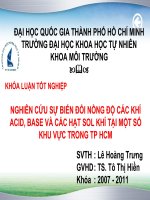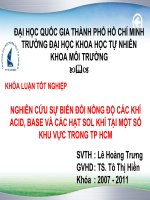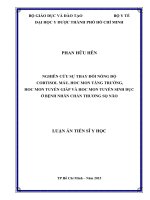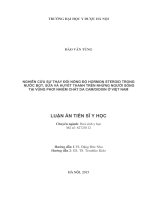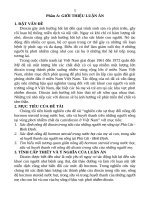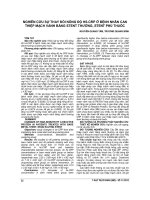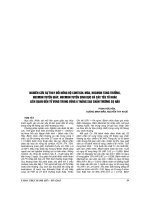Nghiên cứu sự thay đổi nồng độ c3, c4, IL 6 và hsCRP huyết thanh ở bệnh nhân có hội chứng mạch vành cấp tt tiếng anh
Bạn đang xem bản rút gọn của tài liệu. Xem và tải ngay bản đầy đủ của tài liệu tại đây (143.42 KB, 28 trang )
MINISTRY OF TRAINING AND DUCATION
MINISTRY OF DEFENSE
MILITARY MEDICAL ACADEMY
NGUYEN THI THANH THUY
STUDY ABOUT CHANGES IN
CONCENTRATION OF C3, C4, IL-6 AND hsCRP
IN SERUM OF PATIENTS WITH ACUTE
CORONARY SYNDROME
Speciality: Biomedical Science
Code: 9720101
SUMMARY OF THESIS OF DOCTOR IN MEDECINE
HANOI – 2019
THE THESIS WAS ACCOMPLISHED AT
MILITARY MEDICAL ACADEMY
Scientific Instructors:
1. Prof. PHAM MANH HUNG, DrSc
2. Assoc.Prof. PHAM NGUYEN VINH, Ph.D
Reviewer 1: Prof. HUYNH VAN MINH, Ph.D
Reviewer 2: Assoc.Prof. LE VAN DON, Ph.D
Reviewer 3: Assoc.Prof. PHAM ĐANG KHOA, Ph.D
The thesis was well defended in front of institutional committee at:
hh:mm
dd
mm
yyyy
The thesis may be referred at:
1.
National Library
2.
Library of Military Medical Academy
3.
Library of Heart Institute in Ho Chi Minh City
1
STUDY PROBLEM
Coronary artery disease is one of the most increasingly popular
diseases in both developed and developing countries, including Vietnam. It
accounts for a great proportion of fatal hospitalizations. Coronary artery
disease consists of acute coronary syndrome (ACS) and chronic coronary
artery disease [1]. Studies have identified important biomarkers related to
the process of atherosclerosis and cardiovascular events [2], [3], [4]. The
data have demonstrated that inflammatory markers are associated with an
increased risk of cardiovascular events [5], [6], [7]. Therefore, the study of
inflammatory markers are drawing more and more attention, it helps not
only classify risk factors but also improve prognosis of coronary artery disease.
Among them, the inflammatory markers and nonspecific immune factors
including hsCRP (high sensitive C- reactive protein), complements C3, C4 and
interleukin- 6 are of great interest [11], [12], [13], [14]. In addition to hsCRP
which has a certain prognostic role in ACS, we also need to evaluate other
factors as well as the relationship between them for a comprehensive assessment
[3], [15], [16]. There have been studies about different factors of inflammation
from immune cell surface markers, cytokines, coagulation factors, platelet
surface receptors [17], [18], [19]. Further studies need to be done in order to
highlight the role of cytokines in ACS. Currently in our country, there is no
published study mentioning simultaneously different nonspecific immune
factors such as hsCRP, interleukin-6, complements C3, C4 together with the
prognostic factors of ACS.
From these theoretical and practical bases, we conduct the “Study
about the changes in concentration of C3, C4, IL-6 and hsCRP in serum
of patients with acute coronary syndrome” with the following objectives:
2
1. Study the variation of nonspecific immune markers C3, C4,
interleukin-6, and hsCRP in serum of patients with acute coronary
syndrome.
2. Evaluate the relationship between the changes of C3, C4,
interleukin-6 and hsCRP and several clinical, paraclinical factors in acute
coronary syndrome before and after treatment.
Summary of new contributions of the thesis:
This study mentioned changes in nonspecific immune markers
( including C3, C4, interleukin-6, hsCRP) relating to inflammatory reaction
in patients with acute coronary syndrome. This study analyzes the
correlation between factors C3, C4, interleukin-6, hsCRP
with some
paraclinical and clinical charecteristics and their mutual reactions in acute
coronary syndrome. The study demonstrated that concentration of
interleukin-6 and hsCRP reduced significantly after coronary intervention
procedures.
The study elucidates role of inflammatory response and some immune
factors in the pathogenesis of acute coronary syndrome. Together with
hsCRP, it suggests that interleukin-6 may be valuable in prognosis of acute
coronary syndrome.
Thesis structure:
This study paper has 120 pages, including:
-
Study problem and objectives: 2 pages
-
Introduction: 38 pages
-
Study population and methodology: 15 pages
-
Results: 31 pages
-
Discussion: 32 pages
-
Conclusions and suggestions: 2 pages
3
There are also 51 tables, 7 charts, 3 diagrams, 12 pictures, 156 references
(specifically 13 Vietnamese references, 143 English references).
CHAPTER 1
INTRODUCTION
1.1. EPIDEMIOLOGY OF ACUTE CORONARY SYNDROME
Acute coronary syndrome (ACS), one of the leading causes of death,
is on the rise [1]. Its prevalence is still increasing and a large number of
patients are still suffering from ACS and heart attack [21]. In Vietnam, this
incidence is also augmenting [20].
1.2. PATHOGENESIS OF ACUTE CORONARY SYNDROME WITH
THE ROLE OF IMMUNE MARKERS
An inflammatory process takes place in the pathogenesis of ACS [22],
[23], [24]. The focal inflammatory cells release cytokines to activate
endothelial cells, and proinflammatory cytokines to promote the break off of
atherosclerotic plaques. Since the 1990s, the role of inflammatory
biomarkers in ACS has been clearly indicated [25], [26], [27. Intermediate
elements secreted from immune cells promote injury progression and
activate inflammation in atherosclerotic plaques, leading to ACS [28], [29].
New strategies in prognosis, prevention and treatment have been noticed
from the background pathogenesis study [30], [31].
1.2.1. Atherosclerosis in the pathogenesis of acute coronary syndrome
Acute coronary syndrome is caused by atherosclerotic process. Many
factors are responsible for the instability of atherosclerotic plaques resulting
in ACS [37], [38], [39]. Epidemiological studies have shown a close
association between the clinical presentation of atherosclerosis and systemic
inflammatory markers. Many immune cells have signs of activation and
production of inflammatory cytokines at atherosclerotic plaque. Most cases
of myocardial infarction are due to thrombosis, and the two main causes of
4
coronary artery thrombosis are: atherosclerotic plaque ruptures and
endothelial ulcers [40], [41], [42].
1.2.2. Lipoprotein accumulation and role of immune cells
1.2.2.1. Role of endothelial activation, adhesion molecules and
chemokines
1.2.2.2. Role of innate immune system and macrophages in the
development of atherosclerotic plaques
Innate immunity plays an important role in ACS through the activation
of monocytes, neutrophils, eosinophils and mastocytes. The macrophages
activate the production of inflammatory cytokines, protease, cytotoxic oxygen,
and nitrogen compounds [43].
1.2.2.3. Role of adoptive immune system and lymphocytes in
inflammatory response
There is always an infiltration of T cells in atherosclerotic lesion.
When T cell receptors bind to antigens, the cellular activation leads to the
production of cytokines, surface molecules and enzymesConsequently,
increased IL-6 and CRP levels in the peripheral blood trigger an effective
local and systemic inflammatory cascade [24], [43], [44], [45].
1.2.4. Roles of cytokines and other factors in acute coronary syndrome
Proinflammatory cytokines can reduce the synthesis and increase the
degradation of the matrix, promoting the rupture of atherosclerotic plaques.
1.2.5. Other factors involved in the pathogenesis of
acute coronary syndrome
- Environment, physique: Environmental, physical, or emotional
stress trigger MI by activating a sympathetic overload.
-
Physicochemical
changes
of
atherosclerotic
plaques:
Environmental changes including saturated cholesterol, temperature, pH and
5
cholesterol crystal increase the volume of atherosclerotic plaques
significantly, causing sudden rupture and blood clot formation.
- Changes in microcirculation function: The coronary vasospasm is
activated by the reactions of smooth muscle cells.
1.3. CLINICAL PRESENTATION AND DIAGNOSIS OF ACUTE
CORONARY SYNDROME
Clinical presentation: In MI, the patient feels a deep pain inside the
body. Other symptoms include: feeling weak, sweating, nausea, vomiting,
dizziness and anxiety[1], [21].
Paraclinical findings: ECG; changes in biomarkers; chest X-ray;
Echocardiography; Stress test; Coronary angiography.
Diagnosis: Diagnosis is based on clinical symptoms, physical
examinations, and paraclinical findings combined with biomarkers, and the
ultra-sensitive troponins provide an early and specific diagnosis and
evaluation of myocardial injury [50], [51].
Treatment of acute coronary syndrome: includes coronary
revascularization and internal medicine management [52].
1.4. CHANGES OF THE INFLAMMATORY MARKERS AND
CYTOKINES IN ACUTE CORONARY SYNDROME
1.4.1. Interleukin-6: IL-6 is a cytokine which has important effects on
inflammation and blood formation. IL-6 is encoded by IL-6 gene located on
chromosome 7. Its molecular weight is about 22 to 30 kDa. IL-6 acts as a
proinflammatory cytokine produced by different cell types, including
activated T cells, macrophages and some other cells. IL-6 has local effects,
involved in the formation of atherosclerotic plaques and the progression to
ACS. MI has a higher level of IL-6 compared with unstable angina [53].
Increased IL-6 levels help identify the patient groups who may benefit from
the intensive treatment to reduce the mortality [54], [55], [56]. The anti-
6
inflammatory drugs aspirin and statin reduce CRP and IL-6, inhibit
inflammatory reaction, this knowledge shows the role of the antiinflammatory drugs such as aspirin and statin in ACS [57], [58],[59].
1.4.2. CRP: CRP is an acute-phase protein, belongs to Pentraxin group, and
featuring an annular, homopentameric structure. CRP is synthesized in acute
inflammatory phase in the liver under the influence of IL-6. CRP leads to
programmed death of smooth muscle cells, promotes atherosclerosis and
contributes to the instability of atherosclerotic plaques [38], [60], [61].
1.4.4. Complements C3, C4
Complements, a group of proteins, are a part of nonspecific innate
humoral immune system, they act as chain reaction enzymes, creating
effective molecules in the inflammatory process. More evidence suggests
the important role of complements in the pathogenesis of ACS [62], [63],
[64].
1.4.5. Relevancy to treatment
Many studies have shown that patients with obstructive atherosclerosis
ACS and increased inflammatory marker levels have a worse prognosis.
Therefore, re-evaluating the inflammatory status after hospital discharge can
be helpful in identifying coronary atherosclerotic patients with a high risk of
instability recurrence.
1.5. OTHER RELEVANT STUDY
1.5.1. International study: Studies conducted that inflammation plays an
important role. in the onset and progression of atherosclerotic plaques.
through evaluating inflammatory factors such as the complements C3, C4,
hsCRP and IL-6. Studies have demonstrated that hsCRP is the gold standard
in assessing risk factors of cardiovascular events in ACS [10], [32].
1.5.2. Domestic study: In Vietnam there have been several separate studies
about CRP in ACS. The role of cytokine IL-6 has been studied in infectious
7
diseases and cardiovascular surgeries. An increased IL-6 level is linked to an
increased risk of cardiovascular events [5], [12], [13], [20]. Concurrent
studies about different nonspecific immune factors in ACS are still limited.
CHAPTER 2
STUDY SUBJECTS AND METHOD
2.1. STUDY SUBJECTS
2.1.1. Study patients group
A group of 100 patients with confirmed diagnosis as acute coronary
syndrome were admitted to emergency department of Heart Institute in Ho
Chi Minh City from January 2013 to February 2013. All patients were
diagnosed upon acute coronary syndrome criteria (as per new definitions of
Myocardial Infarction in 2012 from cardiology associations incl.
ESC/ACCF/AHA/WHF)[65]. Those who were admitted to emergency
department, eligible for inclusion and exclusion criteria were recruited into
study group.
2.1.2.Control group: included 50 healthy subjects with no coronary artery
disease, selected randomly at the same time from blood donors at Heart
Institute in Ho Chi Minh City.
2.1.3. Selection criteria: All patients with acute coronary syndrome.
2.1.4.Exclusion criteria: Patients with non-infectious inflammation at study
time.
2.2. STUDY METHOD
2.2.1. Study design
Controlled, prospective cohort study. This is a prospective longitudinal
follow up of 100 patients. We used one ratio sample size estimation formula
to calculate number of patients with acute coronary syndrome that needed to
be followed up.
Group 1: Patients with acute coronary syndrome, n=100.
8
Group 2: Control group, 50 healthy subjects, selected from blood
donors.
2.2.2. Study endpoints
Quantifying non-specific immune markers: C3, C4, IL-6 và hsCRP.
Other endpoints: hsTroponin T and NT-ProBNP. Clinical endpoints collected
from patients’ history, medical history in medical records. Other paraclinical
endpoints gathered from patients’ medical records.
PATIENT GROUP
n=100 patients with Acute Coronary Syndrome(ACS)
Collect clinical, paraclinical data and risk factors
from medical records
Paraclinical and clinical
data
-ACS: Diagnosis,
subgroups.
- Treatment method.
- Cardiosonography, ECG,
coronary angiography.
- Hematology tests, routine
Risk factor
- Antecedent of diabetes.
- Smoking,
- Dyslipidemia
- Hypertension
Evaluate correlation
Take blood sample once at admission
for testing non-specific immune
markers and myocardial markers C3,C4,
IL-6, hsCRP,hsTroponin, NT-ProBNP
Compare before and after
treatment on the same subjects
(37 patients)
Take second blood sample 6 months
after treatment
Testing non-specific immune
markers and myocardial markers
Compare
patient
group and
control
group
CONTROL GROUP
n=50
healthy blood
donors
Take blood sample
during blood donation
Testing non-specific
immune markers and
myocardial markers
C3,C4, IL-6, hsCRP,
hsTroponin, NT-ProBNP
9
Chart 2.2: Study chart
2.2.3. Quantitative testing method of C3, C4, IL-6 and hsCRP: by
techniques based on immune principles on diagnostic system and reagent of
Roche Diagnostics
2.2.4. Other quantitative factors in the study: hsTroponinT and NTProBNP, other tests that are quantified by diagnostic systems of Roche
Diagnostics. White blood cell number is analyzed in whole blood sample
with EDTA anticoagulant by hematology system of Beckman- Coulter using
laser technology.
2.2.5.Tasks conducted in study
Collecting paraclinical and clinical parameters. Quantifying factors
including C3, C4, IL-6, hsCRP and hsTroponin, NT-ProBNP at all study
points. Through data analysis to define correlation between every factor (C3,
C4, IL-6, hs CRP) with ACS; evaluate changes of non-specific immune
factors (C3, C4, IL-6, hs CRP) before and after treatment.
2.2.6. Data processing
Collected data were input in Excel software, and processed by
statistical software STATA 12.
2.3. Study ethics
From study ethical point of view, we just learn from the results of
study, which were inherited from indications and decisions of clinical
physicians. During the study, our activities didn’t interfere and did not
impact physicians’ treatment decisions, or treatment protocol, so it didn’t
yield any harm to patients. The study was approved by Scientific- Ethical
Council Of Heart Institute in Ho Chi Minh City.
2.4. Location and time of study
10
The study was conducted at Heart Institute in Ho Chi Minh City.
Samples were collected from 1/2013 to 12/2014.
CHAPTER 3
STUDY RESULTS
3.1. COMMON CHARACTERISTICS OF THE STUDY SAMPLE
3.1.1. Age: using the category by year
Control group: Mean age 33,72 ± 7,88 (Mean ± 2SD). Treatment
group: Mean age 63,67 ± 11,7 (Mean ± 2SD). Patient’s age groups: patients
younger than 60 years old: 41 ( 41%) and patients over 60 years old: 59
( 59%). The majority of patients aged between 50 and 79, the highest age
group was over 60 years old.
3.1.2. Gender: The proportion of male is higher than female. Patient group:
Male: 66 ( 66%), Female: 34 ( 34%). Control group: Male: 38 (76%),
Female: 12 ( 24%).
3.1.3. Follow-up after treatment of the patient group
There were 37 cases (n=37) with following characteristics : Male: 24
patients ( 65%), higher than Female: 13 patients 35%). The mean age of
patients in this group: 63 ± 11,29.
3.1.4. Risk factors and other characteristics
3.1.4.1. Risk factor and white blood cell count
The majority of patient have hypertension. The rate of patients with
leukocytosis is rather high.
3.1.4.2.
Assessment
of
coronary
artery
stenosis
by
coronary
angiography
Patients with coronary angiography: 77 cases, therein: Narrowing of
one branch of coronary artery: 13 cases ( 16,9%), Narrowing of multiple
11
branches of coronary artery: 64 cases ( 83,1%). Patients with stenosis in
multiple branches of coronary artery occupied the majority of cases.
3.1.4.3. Changes of
echocardiography: Most cases have the myocardial
motion abnormalities on echocardiography . Abnormal myocardial motion
images included hypokinetic and/or akinetic myocardial walls: 90% cases
( 90%)
3.1.4.4. The classification of different disease groups in acute coronary
syndrome: ST-segment elevation myocardial infarction (STEMI): 32 cases (
32%), non- ST-segment elevation myocardial infarction (NSTEMI): 59
cases ( 59%), Unstable angina: 9 cases ( 9%).
In the follow-up after treatment of the patient group, 37 cases, had:
STEMI 15/37 cases ( 40,54%), NSTEMI 18/37 cases ( 48,65%), Unstable
angina 4/37 cases ( 10,8%), lower than the above two groups.
3.1.4.5. Treatment method: Internal medicine managementt: 35 cases
( 35%), Coronary artery intervention: 55 cases ( 55%), coronary artery
bypass graft (CABG): 10 cases ( 10%). The coronary artery intervention
method was the highest rate method , next was the internal medicine
management .
3.1.4.6. Mean quantity and concentration of some relating factors
The mean white blood cell count increased slightly, an increase in the
mean platelet count was not found, mean LDL-C concentration increased,
mean eGFR= 64,11ml/min.
3.2. CONCENTRATION OF NONSPECIFIC IMMUNE MARKERS
DETERMINED IN THE PATIENT AND CONTROL GROUP
3.2.1. The concentration of cytokine IL-6 in the patient and control
group
Median IL-6 concentration increased drastically in the patient group
(13,88pg/ml), the median of IL-6 concentration in plasma of the patient
12
group and control group showed a statistically significant difference (p <
0,05).
3.2.2. The mean concentration of the complement C3, C4
The mean level in the patient group was higher than in the control group,
there was a statistically significant difference of mean serum C3, C4 level
between the patient group and control group (p < 0,05).
3.2.3. The concentrations of other markers
Including hs-CRP, hs-Troponin T, and NT-pro BNP. The mean level in
the patient group was statistically higher than in the control group, p < 0,05.
3.3.STUDY
THE
RELATIONSHIP
BETWEEN
THE
CONCENTRATIONS OF C3, C4, IL-6, hsCRP MARKERS IN
ACUTE CORONARY SYNDROME WITH SOME RISK FACTORS
AND THE DISEASE STATES
3.3.1. The change of markers concentration upon age groups
Comparison the factors concentration between two age groups (less
than or equal to 60 years old and greater than 60 years). Before and after
treatment: IL-6 median level showed a statistically significant difference (p
< 0,05); C3 mean level showed a statistically significant difference (p <
0,05); mean C4 level didn’t show statistically significant difference (p >
0,05); median hs-CRP level didn’t show statistically significant difference
(p > 0,05); NT-pro BNP median level showed a statistically significant
difference (p < 0,05). Median
hs-Troponin T level was showed a
statistically significant difference after treatment between two age groups (p
< 0,05)
3.3.2. The change of markers concentration between male and female
13
Median IL-6, hs-CRP level in male and female group didn’t show a
statistically significant difference before and after treatment (p > 0,05). Mean
C3 level before treatment was statistically significant different (p < 0,05),
Median hs-Troponin T level was statistically higher in the male group before
and after treatment (p < 0,05). Median NT-pro BNP level didn’t show a
statistically significant difference before and after treatment in both groups (p >
0,05).
3.3.3. The change of markers concentration upon hypertension factor
Median IL-6 level in the hypertensive patient group was higher than in
the non-hypertensive patient group, however, the difference was statistically
non-significant before and after treatment (p > 0,05). Mean C3, C4 level
between two group were not statistically
different (p > 0,05). Median
hs-Troponin T level in the hypertensive patient group was lower before
treatment with a statistically significant difference (p < 0,05). Before and
after treatment, median hs-CRP, NT-pro BNP level were lower in the
hypertensive patient group with no statistically significant difference, (p >
0,05).
3.3.4. The change of markers concentration upon
dyslipidemia
condition
In dyslipidemia group and non-dyslipidemia group, median IL-6 level
in dyslipidemia groups was higher but no statistically significant difference
(p > 0,05). Mean
C3, C4 level didn’t show
statistically significant
difference (p > 0,05). Before and after treatment, median hs-CRP, hsTroponin T and NT-pro BNP level didn’t show
statistically significant
between two groups (p > 0,05).
3.3.5. The changes of markers concentration upon smoking history
In the smoking group and the non-smoking group, median IL-6 level
didn’t
show a statistically significant difference (p > 0,05). Before
14
treatment, mean C4 level in smoking group was higher than non smoking
group with a statistically significant difference (p < 0,05). Before and after
treatment, mean C3 level and median hs-CRP, hs-Troponin T, NT-pro BNP
level didn’t show a statistically significant difference between smoking
group and non-smoking group (p > 0,05).
3.3.6. The changes of markers concentration upon diabetes
In the diabetes group and the non-diabetes group: Before and after
treatment, median IL-6 level in the non-diabetes group was higher than the
diabetes group but no statistically significant difference (p > 0,05). Mean
C3, C4 level didn’t show a statistically significant difference between two
groups (p > 0,05) Before treatment, median hs-Troponin T level in nondiabetes group was higher with a statistically significant difference (p <
0,05). Before and after treatment, median hs-CRP, NT-pro BNP level didn’t
show statistically significant difference between two group ( p > 0,05).
3.3.7. The changes of markers concentration upon number of narrowed
coronary artery branch
Median IL-6 level between one narrowed branch group and multiple
narrowed branches group didn’t show statistically significant difference (p
> 0,05) Mean C3, C4 levels didn’t show statistically significant difference
between two groups (p > 0,05). Median hs-Troponin level was statistically
significant different(p < 0,05). hs-CRP, NT-pro BNP factors between two
group showed no statistically significant difference (p > 0,05).
3.3.8. The changes of C3, C4, IL-6, hsCRP marker concentration and
other factors among patient groups in acute coronary syndrome
3.8.1. The difference of factors level between the STEMI group and the
unstable angina group
Median IL-6 level didn’t show statistically significant difference
between STEMI group and unstable angina group (p > 0,05). Mean C3, C4
15
level in these two groups were different but not statistically significant (p >
0,05). Before treatment, median hs-Troponin and NT-pro BNP level was
statistically significant different between two groups (p < 0,05) with median
NT-pro BNP higher in unstable angina group. Before and after treatment,
median hs-CRP
level didn’t show
statistically significant difference
between s two groups (p > 0,05).
3.3.8.2. The difference of markers level between the NSTEMI group and
the unstable angina group
Median IL-6 level didn’t show a statistically significant difference
between NSTEMI group and unstable angina group (p > 0,05). Mean C3,
C4 level in these two groups were different but not statistically significant
(p > 0,05). Median hs-CRP, hs-Troponin and NT-pro BNP didn’t show
statistically significant difference between NSTEMI group and unstable
angina group (p > 0,05).
3.3.8.3. The difference of markers level between the MI group and the
unstable angina group
Median IL-6 level didn’t
show statistically significant difference
between two groups (p > 0,05). Mean C3, C4 level between MI group and
unstable angina group were different but not statistically significant (p >
0,05). Before treatment, median NT-pro BNP level in unstable angina
group was higher than in MI group with a statistically significant difference
(p < 0,05). After treatment, mean hs-Troponin T level in unstable angina
group was higher with a statistically significant difference (p < 0,05).
Median
hs-CRP level didn’t show
statistically significant difference
between two groups(p > 0,05).
3.4. STUDY THE RELATIONSHIP AMONG MARKERS IN ACUTE
CORONARY SYNDROME
3.4.1. Analysis of the relationship among markers
16
Analyzing the mono-variate correlation among factors: There was
proportional correlation between C3 and C4; hsCRP and IL-6; hs-Troponin
T and NT-pro BNP with statistical significance (p < 0,05).
3.4.2. Analysis of the relationship among all inflammatory markers
Analyzing the multi-variate
correlation among the inflammatory
factors C3, C4, IL-6, hs-CRP: When testing the relationship among all
inflammatory factors, there was correlation between C3 and C4; IL-6 and
hs-CRP with statistical significance (p < 0,05).
3.4.3. The relationship between the inflammatory markers and other
markers
Analysis of the relationship among all factors (C3, C4, IL-6, hs-CRP,
hs-Troponin, and NT-pro BNP): when considering the correlation among all
factors (multi-variate correlation), there was correlation between two
inflammatory factors C3 and C4 with statistical significance (p < 0,05). No
correlation between inflammatory factors and hs-Troponin/ NT-pro BNP.
3.5. THE CHANGE OF NONSPECIFIC IMMUNE MARKERS
CONCENTRATION BEFORE AND AFTER TREATMENT
3.5.1. The change of median IL-6 cytokine level before
and after treatment
Median IL-6 level before treatment was 16,59pg/ml, after treatment was
3,99 pg/ml, decreased clearly with a statistically significant difference (p <
0,05).
3.5.2. The change of mean C3, C4 complement level before and after
treatment
Mean
C3, C4 level tended to decrease after treatment but the
difference was not statistically significant (p > 0,05).
3.5.3. The change of other markers level before and after treatment
17
After treatment, median hs-CRP, hs-Troponin, NT-pro BNP level
decreased clearly – the difference was statistically significant (p < 0,05).
3.6. THE CHANGE OF NONSPECIFIC IMMUNE MARKERS
CONCENTRATION BEFORE AND AFTER TREATMENT UPON
DIFFERENT TREATMENT METHODS
3.6.1. Internal medicine management
By internal medicine management , median IL-6 level didn’t show a
statistically significant difference before and after treatment (p > 0,05).
Mean C3, C4 level did not show statistically significant difference before
and after treatment (p > 0,05). Median level of other factor as hs-CRP, hsTroponin, NT-pro BNP didn’t
show
statistically significant difference
before and after treatment (p > 0,05).
3.6.2. Coronary artery intervention
After treatment by coronary artery intervention method, median IL-6
level dramatically reduced – the difference was very statistically significant
between before and after treatment (p < 0,001). Mean C3, C4 level had the
decreasing trend, however, the difference was not statistically significant (p
> 0,05). hs-CRP, hs-Troponin, NT-pro BNP level reduced clearly with a
statistically significant difference (p < 0,05).
3.6.3. Surgery
After CABG treatment, median IL-6 level decreased but the difference
was not statistically significant between before and after treatment (p >
0,05). In the CABG group, C3 and C4 level did not show statistically
significant difference between before and after treatment (p > 0,05). Median
hsCRP level did not
show
statistically significant difference between
before and after treatment (p > 0,05). Median hsTroponin, NT-pro BNP
18
factor level decreased after treatment – the difference was statistically
significant (p < 0,05).
CHAPTER 4
DISCUSSIONS
4.1.GENERALCHARACTERISTICS OF THE STUDY POPULATION
4.1.1. Age and sex
In this study, the mean age of patients with ACS is 63,67 years old.
There are more males than females (76% and 24% respectively). These
results are consistent with previous studies [12], [13], [66]. The mean age of
the control group is younger than that of the patient group with a similar sex
ratio. The results show a high proportion of patients over 60 years old,
consistent with the studies [14], [20].
4.1.2. Risk factors and other factors
A great proportion of patients with acute coronary syndrome are
hypertensive, which was shown similarly in other studies [67], [68], [69]. In
the pathophysiologic process, atherosclerotic lesions of large arteries lead to
hypertension, then continue to progress in small vessels including coronary
arteries [4], [15],[18]. Other risk factors, dyslipidemia, diabetes, smoking
have the same rates as in other studies [69], [70], [71]. Patients with
increased lymphocyte count account for 59,4%, in atherosclerotic plaques,
the presence of immune cells stimulate the inflammatory process, there is
infiltration and mobilization of lymphocytes into the unstable atherosclerotic
plaques, and this can lead to a response to increase the number of
lymphocytes in peripheral blood, in addition to monocytes, mastocytes,
neutrophils which are of interest in acute coronary syndrome, releasing
inflammatory cytokines in atherosclerotic plaques which will then cause
19
instability and rupture of these plaques [40], [72], [73], in the inflammatory
response of acute coronary syndrome there is an increase of monocytes, T
cells, neutrophils and chemokines [74], [75]. Percutaneous coronary
angiography results show single stenosis or multiple stenosis, but most
patients have multiple stenosis, accounting for 83,1%, and this is in line with
the pathogenesis of acute coronary syndrome with stenosis[38], [41], [46],
coronary artery stenosis is due to different mechanisms including
inflammation and thrombosis. When evaluating changes in myocardial
dynamics by echocardiography: myocardial wall dyskinesia and akinesia are
seen in most ACS
cases,consequently myocardial and left ventricular
systolic dysfunction [50]. The majority of the patients have non ST elevation
MI, followed by ST elevation MI with a clinical increase in myocardial
necrosis biomarkers, Troponin. Ultrasensitive Troponins are important
biomarkers which aid in the diagnosis [76], [77], [78], [79]. Tỷ lệ các nhóm
bệnh có thể phụ thuộc vào thời gian bệnh nhân nhập viện, theo diễn tiến tổn
thương động mạch vành [80], [81]. Regarding the treatment methods,
coronary intervention accounts for the highest proportion.
Evaluating the mean number and concentration of several related
factors. Creatinine concentration, glomerular filtration rate, HDL and LDL
concentration provide overall information about their characteristics in
patients with ACS. The mean concentration of Creatinin does not increase
significantly; and the mean glomerular filtration rate does not decrease
much in the study population. LDL- cholesterol mean levels increase and
HDL- Cholesterol levels decrease. With regard to the pathophysiologic
mechanism, LDL is an important part involved in the formation, progression
and rupture of atherosclerotic plaques, the role of LDL has been much
mentioned in the pathogenesis of ACS as a criteria for treatment monitoring.
20
4.2. CHANGES OF NONSPECIFIC IMMUNE MARKER LEVELS IN
ACUTE CORONARY SYNDROME
4.2.1. Cytokine and inflammatory markers
The study results show an obvious increase of IL-6 levels in patients
with ACS, there is a statistically significant difference between patient group
and control group with p<0,001, in line with previous studies [13],[40],[84],
[85]. Recent studies have proved that inflammatory response plays a key
role in CAD, cytokines are secreted by immune cells to promote the
development of injury and activation of inflammatory process, leading to
ACS. A great amount of intermediate factors into the cytokine cascades, IL6 and CRP increase as a consequence and can be detected in the peripheral
circulation. The activated immune cells produce inflammatory cytokines,
including cytokine IL-6. IL-6 stimulates tissues, especially hepatocytes, to
produce acute-phase proteins such as CRP [24]. These study results are in
line with previous studies and with the pathogenesis of ACS [19], [86], [87].
Changes in IL-6 levels are a prognostic factor for the patients [88], [89],
[90]. The studies show that proinflammatory cytokines, including IL-6, play
an important part in the progression and instability of atherosclerotic
plaques that lead to ACS [91], [92], [93], [94].
The mean levels of complements C3, C4 increase significantly in the
patient group. There are not many studies on the role of complements C3,
C4, especially in ACS [95]. Complements work by chain reaction to create a
complement cascade, once activated will trigger inflammatory process.
These study results are in line with previous studies and with the
inflammatory response mechanism in ACS [96], [97], [98], [99]. The
activation of complement system in patients with ACS suggests that C3, C4
be related to myocardial necrosis [100], [101], [102]. Studies about the
21
prognostic value of the inflammatory markers IL-6, hsCRP provide
additional information to assess clinical risks in patients with ACS [103].
Recent studies in the world have demonstrated the role of different
biomarkers in acute coronary syndrome [106], [107], [108], [109]. The
increased levels of inflammatory markers IL-6, CRP, C3, C4 are associated
with an increased risk of cardiovascular events. These studies suggest that
the simultaneous assessment of the inflammatory factors is essential not
only to diagnose the myocardial injury in ACS but also to predict disease
progression as well as treatment outcomes [84], [110]. The studies show IL6 levels increase together with CRP and other factors such as TNF,
homocystein, lymphocytes in ACS [91],[111], [112]. The inflammatory
markers CRP, IL-6 can help classify risks as prognostic factors in ACS[113],
[114],[115], a rise in IL-6 levels can help identify the patients who can
benefit from intensive treatment with a reduced mortality. IL-6 increases in
unstable atherosclerotic plaques and drops after percutaneous coronary
intervention, the presence of IL-6 results in inflammatory response at the
injured artery and plays a crucial role in late restenosis after percutaneous
coronary intervention, thus having a prognostic value [115],[116], [117].
There is a relationship between IL-6 and the formation and destabilization of
atherosclerotic plaques. The anti-inflammatory drugs such as aspirin and
statin reduce CRP and IL-6, and inhibit inflammation. [10], [40], [57]. The
inflammatory biomarkers can provide other clinical information, as
biomarkers of myocardical necrosis and increased hemodynamic tension
[90], [118], [119].
4.2.2. Other markers
hsTroponin and NT-Pro BNP increase remarkably in the patient group
compared with the control group. Troponins are considered as important
biomarkers in diagnosis and prognosis of acute coronary syndrome, the
22
ultrasensitive Troponins are mentioned in the updated diagnosis of ACS
[77], [78], [120], [121]. Troponins are very valuable in short and medium
term risk classifications of unstable angina and MI. NT- ProBNP
is
highlighted as a prognostic factor of acute coronary syndrome. Increased
NT-ProBNP levels are associated with an increased mortality [71], [122],
[123], [124] .
4.3. EVALUATE THE CORRELATION BETWEEN THE CHANGES
OF NONSPECIFIC IMMUNE MARKER LEVELS IN ACUTE
CORONARY SYNDROME AND OTHER FACTORS
The inflammatory factor levels between groups of patients with and
without hypertension do not show a statistically significant difference, the
non-hypertensive group tends to have higher levels, these initial data need to
be further tested, to understand the mechanism, and evaluate carefully
Troponin levels in patients with ACS and these two conditions. With regard
to dyslipidemia, the inflammatory factors show no difference, this might be
due to the increase of inflammatory factors with acute inflammation, and
might be an advantage when evaluating acute on chronic diseases. The
levels of inflammatory factors of the patients with diabetes do not show any
significantly difference with the diabetes-free group, although diabetes and
atherosclerosis have the same pathophysiologic mechanism of chronic
inflammatory response [41]. In patients with one or multiple coronary
branch stenosis, the results do not show any statistically significant
difference between the factors, there might not be a correlation between the
stenotic phenomenon and inflammatory response, it is the activation of
atherosclerotic plaques rather than the stenosis which causes ischemia and
infarction [31], [46].
4.4.
CORRELATION
MARKERS
BETWEEN
NONSPECIFIC
IMMUNE
23
With regard to single variable correlation, there is a correlation
between C3 and C4, hsCRP and C4, IL6, hs-Troponin, and NT-ProBNP. The
study shows that IL-6 is only related to CRP, in accordance with the origin
and role of IL-6, stimulating hepatocytes to produce CRP in acute phase.
With regard to multiple variable correlation, there is a correlation between
C3 with C4 and IL-6 with CRP, independent of other factors.
These results show also a clear correlation between the inflammatory
factors C3, C4, IL-6 và CRPhs and acute coronary syndrome. These are in
line with previous studies [13], [84], [111], [125]. The biomarkers are not
only used for diagnosis but also to identify high risk patients [111],[127],
[128],[129].
4.5. CHANGES OF NONSPECIFIC IMMUNE MARKER LEVELS
AFTER TREATMENT
In the statistical analysis of the patient group evaluated before and after
treatment, the mean concentrations of complements C3, C4 before and after
treatment do not show a statistically significant difference with p>0,05
although they tend to decrease. After treatment, the levels of IL-6 and CRP
show an obvious and statistically significant reduction, while C3, C4 levels
tend to decrease but not statistically significant. These results are in
accordance with other studies [5], [98]. Studies have noticed an obvious
increase of IL-6 in ACS with a prognostic role on cardiovascular events
[133], [134], [135]. The overall studies have shown the role of inflammatory
markers in classifying ACS, IL-6 was found to play a decisive role in the
therapeutic application of ACS, however more study is needed [136], [137],
[138]. hsTroponin and NT-ProBNP levels decrease remarkably after
treatment, with a statistically significant difference p<0,001. Ultrasensitive
Troponin and NT-ProBNP are biomarkers used in the prognosis of ACS
[122], [123], [139]. The study results show that in addition to the

